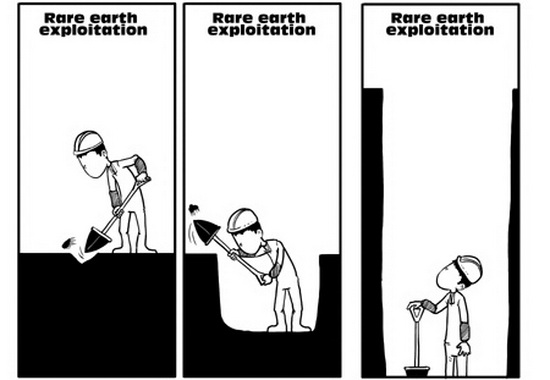Rare earth regulation justified
- By Li Yang
 0 Comment(s)
0 Comment(s) Print
Print E-mail China Daily, August 1, 2012
E-mail China Daily, August 1, 2012
|
|
|
[Photo from China Daily] |
A recent trip to Jieyuan village in Ganzhou city of Jiangxi province revealed the huge environmental cost some places have had to pay for the economic development during the past decade. Jieyuan is 20 minutes' drive from the city and has about 2,100 residents, whose per capita income was 4,100 yuan ($650) in 2011. The village is famous for its limestone and related industry.
Although on average villagers earn only $1.79 a day, they are happy with the fast increase in their income in recent years. The fast income growth, however, has not led to a better life. Many of the villagers have kidney stones, others have contracted tuberculosis and some are dying of liver cancer or lung cancer.
The limestone reserve in the village has made cement making a profitable business. But it is also a fatal source of dust pollution. The groundwater is too hard to drink, and the village does not receive potable water supply through pipes.
Jieyuan is just one example of environmental damage in Ganzhou, a main producer of rare earth in China. Statistics show the forest cover of seven counties in the city has been destroyed after rare earth exploitation increased from 32 square kilometers in 2000 to 153 sq km in 2010.
The Ministry of Industry and Information Technology says Ganzhou needs more than 38 billion yuan to restore the environment back to health, that is, if no further damage is caused. In stark contrast to the cost of environmental damage, the city's average annual profit from the rare earth industry has been only about 2 billion yuan in the past decade.
I talked to three ailing and weak widows whose husbands died of cancer. One of them told me that four male family members - her husband, her husband's two brothers and her father-in-law - who used to work in local factories, all passed away in the past year.
Data suggest the environmental loss in China is 5 to 6 percent of the country's GDP. That is to say, the cost of environmental pollution in 2011 amounted to more than 2 trillion yuan, not counting the money needed to control pollution, some of which is irrecoverable.
As one Jieyuan villager says: "We suddenly have everything we dreamt of, but we may have nothing as suddenly because of death." Taking a cue from this, local governments should follow the path of sustainable development to protect the environment and natural resources, so that future generations are not deprived of their share of economic development.
The central authorities have realized the importance of sustainable development and are taking special measures to promote it in the country. For example, only a qualified rare earth producer can register as a legal entity in Ganzhou. Also, it must pass strict environmental assessments and keep its output below the quota imposed by relevant authorities.
Even though China's GDP growth rate declined to 7.6 percent in the second quarter of 2012, the lowest in three years, the country can no longer afford to boost economic growth at the cost of the environment. A slower economic growth is a challenge but also an opportunity. China should take this opportunity to go ahead with its plan of restructuring the economy, and has more than enough reason to strengthen regulations for the rare earth industry.
But the challenge to China's environment is not internal alone. This week news came that "the World Trade Organization has finally agreed to investigate claims by the US, EU and Japan that China is unfairly strangling rare earth exports in order to favor its domestic manufacturing industry".
Instead of trying to fulfill their own interests by pressuring China to lift the restrictions, leaders of these developed countries should go to villages like Jieyuan to see first-hand the human and environmental destruction their demand is causing.
According to China's white paper on rare earth, released on June 20, the country meets more than 90 percent of the rare earth demand in the global market when it has only 23 percent of the world's total reserves. It also supplies more than 70 percent of the world's permanent-magnet, luminescents, and hydrogen-storage and polishing materials, which use rare earth as raw material.
Plus, China-produced rare earth materials, parts and components, as well as rare earth-end products such as energy-saving lamps, special and small electric motors and NiMH batteries satisfy the development needs of high-tech industries of other countries, especially the developed ones.
Developed countries are used to pointing the finger at China when it comes to environmental protection. But when China takes measures to protect the environment, they pressure it to lower its guard just to fulfill their vested interests. Instead of arm-twisting China into fulfilling their demand, they should support it to implement strict environmental measures, including strengthening regulations on the rare earth industry, if they really care about environmental protection.






